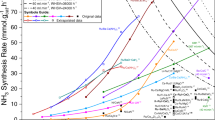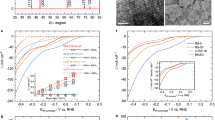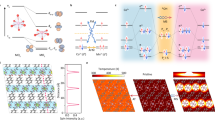Abstract
Ammonia has recently attracted growing attention as a promising hydrogen carrier because it can be liquefied and stored in bulk under mild conditions. To fully harness its potential, more efforts are needed to elucidate and control the mechanisms of its decomposition. Here we show that intermediate dimerization processes proceed through a cooperative spin alignment effect between intermediates and can be promoted by the magnetic ordering rearrangement of magnetic substrates. We explored a series of Co/Pt magnetic thin-film catalysts as model materials to investigate spin-sensitive NHx dimerization and eventual enhancement on catalytic activity. Through in situ spectroscopic analysis and theoretical verification, we demonstrate that coupling of N–NH with aligned net magnetic moments is the most favourable with the lowest energy barriers. This provides a precedent for understanding spin kinetics to help improve the catalytic efficiency of electrochemical ammonia decomposition.

This is a preview of subscription content, access via your institution
Access options
Access Nature and 54 other Nature Portfolio journals
Get Nature+, our best-value online-access subscription
$32.99 / 30 days
cancel any time
Subscribe to this journal
Receive 12 print issues and online access
$259.00 per year
only $21.58 per issue
Buy this article
- Purchase on SpringerLink
- Instant access to full article PDF
Prices may be subject to local taxes which are calculated during checkout




Similar content being viewed by others
Data availability
Source data are provided with this paper.
References
Vogt, E. T. & Weckhuysen, B. M. The refinery of the future. Nature 629, 295–306 (2024).
Soloveichik, G. H2IQ Hour: Ammonia: From Fertilizer to Energy Carriers (US Department of Energy, 2021).
Fu, X. et al. Continuous-flow electrosynthesis of ammonia by nitrogen reduction and hydrogen oxidation. Science 379, 707–712 (2023).
Li, S. et al. Long-term continuous ammonia electrosynthesis. Nature 629, 92–97 (2024).
Green, L. An ammonia energy vector for the hydrogen economy. Int. J. Hydrogen Energy 7, 355–359 (1982).
Chang, F., Gao, W., Guo, J. & Chen, P. Emerging materials and methods toward ammonia-based energy storage and conversion. Adv. Mater. 33, e2005721 (2021).
Chen, J. G. et al. Beyond fossil fuel–driven nitrogen transformations. Science 360, eaar6611 (2018).
Mukherjee, S., Devaguptapu, S. V., Sviripa, A., Lund, C. R. F. & Wu, G. Low-temperature ammonia decomposition catalysts for hydrogen generation. Appl. Catal. B 226, 162–181 (2018).
Adli, N. M., Zhang, H., Mukherjee, S. & Wu, G. Review—ammonia oxidation electrocatalysis for hydrogen generation and fuel cells. J. Electrochem. Soc. 165, J3130–J3147 (2018).
Boisen, A., Dahl, S., Nørskov, J. K. & Christensen, C. H. Why the optimal ammonia synthesis catalyst is not the optimal ammonia decomposition catalyst. J. Catal. 230, 309–312 (2005).
Xie, P. et al. Highly efficient decomposition of ammonia using high-entropy alloy catalysts. Nat. Commun. 10, 4011 (2019).
Rosca, V. & Koper, M. T. M. Electrocatalytic oxidation of ammonia on Pt(111) and Pt(100) surfaces. Phys. Chem. Chem. Phys. 8, 2513–2524 (2006).
Pillai, H. S. et al. Interpretable design of Ir-free trimetallic electrocatalysts for ammonia oxidation with graph neural networks. Nat. Commun. 14, 792 (2023).
Li, Y. et al. Ternary PtIrNi catalysts for efficient electrochemical ammonia oxidation. ACS Catal. 10, 3945–3957 (2020).
Oswin, H. G. & Salomon, M. The anodic oxidation of ammonia at platinum black electrodes in aqueous KOH electrolyte. Can. J. Chem. 41, 1686–1694 (1963).
Gerischer, H. & Mauerer, A. Untersuchungen zur anodischen oxidation von ammoniak an platin-elektroden. J. Electroanal. Chem. 25, 421–433 (1970).
Katsounaros, I. et al. On the mechanism of the electrochemical conversion of ammonia to dinitrogen on Pt(100) in alkaline environment. J. Catal. 359, 82–91 (2018).
Yang, X. et al. Achievements, challenges, and perspectives on nitrogen electrochemistry for carbon‐neutral energy technologies. Angew. Chem. Int. Ed. 135, e202215938 (2023).
Trenerry, M. J., Wallen, C. M., Brown, T. R., Park, S. V. & Berry, J. F. Spontaneous N2 formation by a diruthenium complex enables electrocatalytic and aerobic oxidation of ammonia. Nat. Chem. 13, 1221–1227 (2021).
Garcés-Pineda, F. A., Blasco-Ahicart, M., Nieto-Castro, D., López, N. & Galán-Mascarós, J. R. Direct magnetic enhancement of electrocatalytic water oxidation in alkaline media. Nat. Energy 4, 519–525 (2019).
Wu, T. & Xu, Z. J. Oxygen evolution in spin-sensitive pathways. Curr. Opin. Electrochem. 30, 100804 (2021).
Dougherty, D. A. Spin control in organic molecules. Acc. Chem. Res. 24, 88–94 (1991).
Goodenough, J. B. Spin–orbit-coupling effects in transition-metal compounds. Phys. Rev. 171, 466–479 (1968).
Gracia, J. Spin dependent interactions catalyse the oxygen electrochemistry. Phys. Chem. Chem. Phys. 19, 20451–20456 (2017).
Mott, N. F. Electrons in transition metals. Adv. Phys. 13, 325–422 (1964).
Ermolaeva, O. L. et al. Magnetic force microscopy of nanostructured Co/Pt multilayer films with perpendicular magnetization. Materials (Basel) 10, 1034 (2017).
Charilaou, M. et al. Magnetic properties of ultrathin discontinuous Co/Pt multilayers: comparison with short-range ordered and isotropic CoPt3 films. Phys. Rev. B 93, 224408 (2016).
Rellinghaus, B., Weller, D., Tran, M. Q. & Hellman, F. Growth-induced magnetic anisotropy and clustering in vapor-deposited Co–Pt alloy films. Phys. Rev. B 60, 12826–12836 (1999).
Wang, K. et al. Optimization of Co/Pt multilayers for applications of current-driven domain wall propagation. J. Appl. Phys. 110, 083913 (2011).
Haazen, P. P. J. et al. Domain wall depinning governed by the spin Hall effect. Nat. Mater. 12, 299–303 (2013).
Duan, H. et al. Beating the exclusion rule against the coexistence of robust luminescence and ferromagnetism in chalcogenide monolayers. Nat. Commun. 10, 1584 (2019).
Cross, J. O. et al. Growth induced magnetic and chemical anisotropy in CoPt3 alloy films. J. Synchrotron Radiat. 8, 880–882 (2001).
Jakubowski, M. M. et al. On defects’ role in enhanced perpendicular magnetic anisotropy in Pt/Co/Pt, induced by ion irradiation. J. Phys. Condens. Matter 31, 185801 (2019).
Wei, C. et al. Recommended practices and benchmark activity for hydrogen and oxygen electrocatalysis in water splitting and fuel cells. Adv. Mater. 31, 1806296 (2019).
Gao, H. et al. Reducing the Ir−O coordination number in anodic catalysts based on IrOx nanoparticles towards enhanced proton-exchange-membrane water electrolysis. Angew. Chem. Int. Ed. 62, e202313954 (2023).
Wang, S. et al. Electrochemical impedance spectroscopy. Nat. Rev. Methods Primers 1, 41 (2021).
Zheng, X. et al. Theory-driven design of high-valence metal sites for water oxidation confirmed using in situ soft X-ray absorption. Nat. Chem. 10, 149–154 (2018).
Vargas-Hernández, R. A. Bayesian optimization for calibrating and selecting hybrid-density functional models. J. Phys. Chem. A 124, 4053–4061 (2020).
Blöchl, P. E. Projector augmented-wave method. Phys. Rev. B 50, 17953–17979 (1994).
Joubert, D. From ultrasoft pseudopotentials to the projector augmented-wave method. Phys. Rev. B 59, 1758–1775 (1999).
Yoo, J., Choi, J., Choi, S., Lee, C. & Lee, H. M. Facet-controlled Pt3M alloys as enhanced catalysts for ammonia oxidation reaction: a combined theoretical and experimental study. ACS Catal. 15, 167–178 (2025).
Su, Y. et al. Ferromagnetic L12-Pt3Co nanowires with spin-polarized orbitals for fast and selective oxygen reduction electrocatalysis. Adv. Funct. Mater. 34, 2311618 (2024).
Biz, C., Fianchini, M., Polo, V. & Gracia, J. Magnetism and Heterogeneous catalysis: in depth on the quantum spin-exchange interactions in Pt3M (M = V, Cr, Mn, Fe, Co, Ni, and Y) (111) alloys. ACS Appl. Mater. Interfaces 12, 50484–50494 (2020).
Grimme, S. Semiempirical GGA-type density functional constructed with a long-range dispersion correction. J. Comput. Chem. 32, 174–182 (2012).
Henkelman, G., Uberuaga, B. P. & Jónsson, H. A climbing image nudged elastic band method for finding saddle points and minimum energy paths. J. Chem. Phys. 113, 9901–9904 (2000).
Henkelman, G. & Jónsson, H. Improved tangent estimate in the nudged elastic band method for finding minimum energy paths and saddle points. J. Chem. Phys. 113, 9978–9985 (2000).
Acknowledgements
This research is supported by the National Research Foundation, Singapore, and A*STAR (Agency for Science, Technology and Research) under its LCER Phase 2 Programme Hydrogen & Emerging Technologies FI, Directed Hydrogen Programme (award number U2305D4003 to Z.J.X.) and the National Research Foundation under its Frontier Competitive Research Programme (NRF-F-CRP-2024-0008 to Z.J.X.). The synchrotron radiation experiments were performed at the Soft X-ray Spectroscopy Beamline at the Australian Synchrotron, with the support of the Singapore-International Synchrotron Access Programme (SG-ISAP) by the National Synchrotron Programme, Singapore to S.Z., T.W. and X.L. We thank the National Nature Science Foundation of China for support (grant number 52072060 to T.L.). S.Z. gratefully acknowledges support from Q. Chen via the National Natural Science Foundation of China (grant number 52125604).
Author information
Authors and Affiliations
Contributions
Z.J.X. conceived the study and supervised the project. S.Z. designed and performed experiments. S.Z., A.Y., T.W., Q.W. and Z.J.X. analysed and interpreted data. X.R., D.D., T.L., Q.W. and M.Y. fabricated the thin films and performed thin-film characterization. Z.J.X. and S.Z. proposed the mechanism. Q.W. performed the theoretical calculations. S.Z., T.W., X.L. and A.T. performed the sXAS experiments. S.Z., C.D. and Z.J.X. wrote and edited the paper. All authors reviewed and edited the paper.
Corresponding author
Ethics declarations
Competing interests
The authors declare no competing interests.
Peer review
Peer review information
Nature Chemistry thanks Leanne Chen, Ping Xu and the other, anonymous, reviewer(s) for their contribution to the peer review of this work.
Additional information
Publisher’s note Springer Nature remains neutral with regard to jurisdictional claims in published maps and institutional affiliations.
Supplementary information
Supplementary Information
Supplementary Figs. 1–28.
Source data
Source Data Fig. 1
Statistical source data.
Source Data Fig. 2
Statistical source data.
Source Data Fig. 3
Statistical source data.
Source Data Fig. 4
Statistical source data.
Rights and permissions
Springer Nature or its licensor (e.g. a society or other partner) holds exclusive rights to this article under a publishing agreement with the author(s) or other rightsholder(s); author self-archiving of the accepted manuscript version of this article is solely governed by the terms of such publishing agreement and applicable law.
About this article
Cite this article
Zhu, S., Wu, Q., Dai, C. et al. Cooperative spin alignment enhances dimerization in the electrochemical ammonia oxidation reaction. Nat. Chem. (2025). https://doi.org/10.1038/s41557-025-01900-1
Received:
Accepted:
Published:
DOI: https://doi.org/10.1038/s41557-025-01900-1



